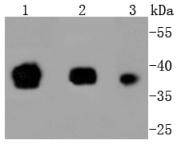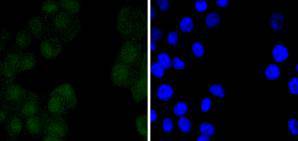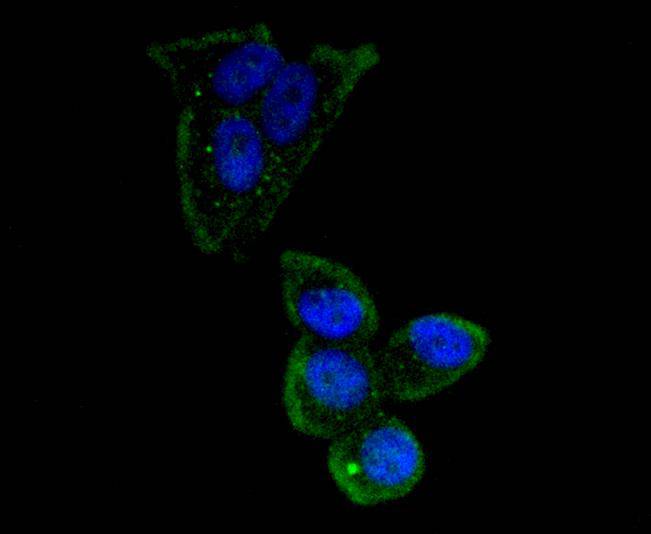Product Detail
Product NameOct4 Rabbit mAb
Clone No.SD0750
Host SpeciesRecombinant Rabbit
Clonality Monoclonal
PurificationProA affinity purified
ApplicationsWB, ICC/IF, IHC, IP, CHIP
Species ReactivityHu, Ms
Immunogen Descrecombinant protein
ConjugateUnconjugated
Other NamesOctamer binding transcription factor 4 antibody MGC22487 antibody Oct 3 antibody Oct 4 antibody Oct-3 antibody Oct-4 antibody OCT3 antibody Oct4 antibody Octamer binding protein 3 antibody Octamer binding protein 4 antibody Octamer binding transcription factor 3 antibody Octamer-binding protein 3 antibody Octamer-binding protein 4 antibody Octamer-binding transcription factor 3 antibody OTF 3 antibody OTF 4 antibody OTF-3 antibody OTF3 antibody OTF4 antibody PO5F1_HUMAN antibody POU class 5 homeobox 1 antibody POU domain class 5 transcription factor 1 antibody POU domain transcription factor OCT4 antibody POU domain, class 5, transcription factor 1 antibody POU-type homeodomain-containing DNA-binding protein antibody POU5F1 antibody
Accession NoSwiss-Prot#:Q01860
Uniprot
Q01860
Gene ID
5460;
Calculated MW39 kDa
Formulation1*TBS (pH7.4), 1%BSA, 40%Glycerol. Preservative: 0.05% Sodium Azide.
StorageStore at -20˚C
Application Details
WB: 1:1,000-5,000
IHC: 1:50-1:200
ICC: 1:50-1:200
Western blot analysis of Oct4 on different lysates using anti-Oct4 antibody at 1/1,000 dilution. Positive control: Lane 1: F9 Lane 2: NCCIT Lane 3: hES
Immunohistochemical analysis of paraffin-embedded mouse liver tissue using anti-Oct4 antibody. Counter stained with hematoxylin.
ICC staining Oct4 in N2A cells (green). The nuclear counter stain is DAPI (blue). Cells were fixed in paraformaldehyde, permeabilised with 0.25% Triton X100/PBS.
ICC staining Oct4 in MCF-7 cells (green). The nuclear counter stain is DAPI (blue). Cells were fixed in paraformaldehyde, permeabilised with 0.25% Triton X100/PBS.
POU5F1 (POU domain, class 5, transcription factor 1), also known as octamer-binding transcription factor-3 (Oct-3, OTF3), octamer-binding transcription factor-4 (Oct-4, Otf-4) and Oct-3/4, modulates embryonic stem (ES) cell populations by influencing lineage commitment. Oct-3/4 sustains stem-cell self-renewal and differentiation pathways. Transcription factors containing the POU homeodomain regulate tissue-specific gene expression in lymphoid and pituitary differentiation and in early mammalian development. Oct-3/4 is capable of inducing rapid proliferation and tumorigenic properties of ES cells through activation of the UTF1 gene. In humans, two Oct-3/4 isoforms contribute to influencing the undifferentiated phenotype of ES cells. Oct-3/4 pseudogenes localizing to human chromosomes 10 and 8 are reported to be transcribed in certain cancer cell lines and tissues.
If you have published an article using product 49129, please notify us so that we can cite your literature.
et al,Liquid Helium Enhanced Vitrification Efficiency of Human Bone-Derived Mesenchymal Stem Cells and Human Embryonic Stem Cells. In Bioengineering (Basel) on 2021 Oct 26 by Mengjia Dou, Chennan Lu,et al..PMID:34821728
, (2021),
PMID:
34821728






 Yes
Yes



